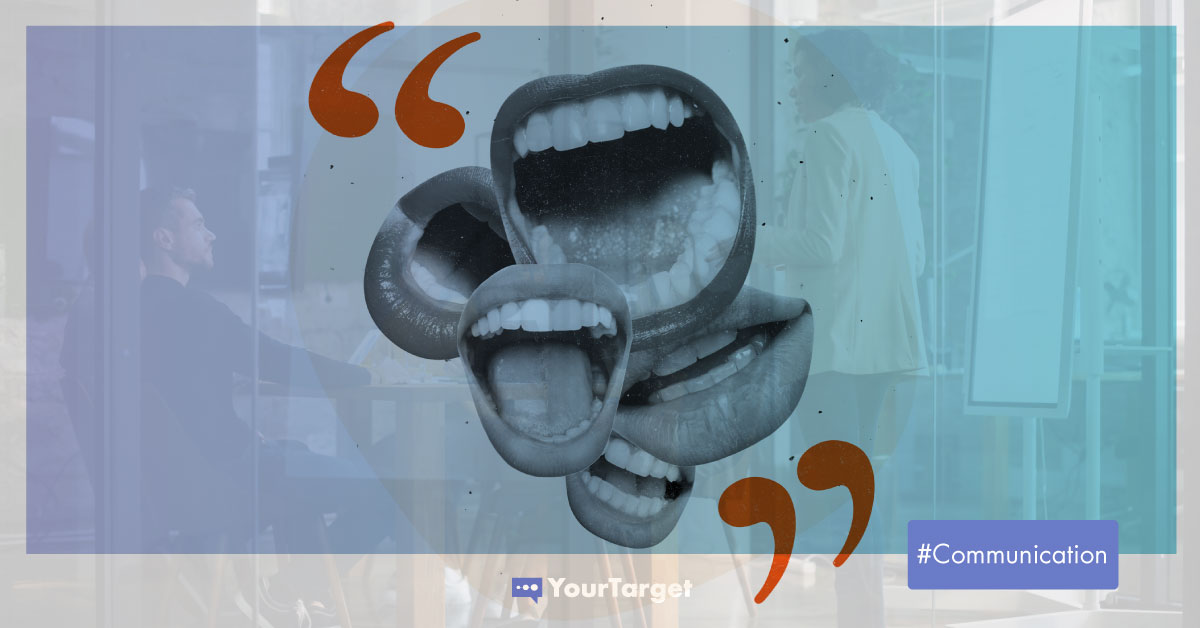“One can not not communicate”
Yes, you can read that quote again, and no, there is no typo. It’s also the title of a compilation of the works written by the Austrian-American therapist, psychologist, communication theorist, and philosopher, Paul Watzlawick.
In his book, Watzlawick states that: “It is impossible not to communicate : In everything we do, we are communicating (something), even in the absence of intent or communication tools (support & media)” Communication is more than just what we write or say, our – conscious and unconscious – behaviour is also a way of communicating. Or, simply put: non-verbal communication is also communication.
Indeed, in everything we do, we are communicating – this is valid for individuals, and also for organizations, corporations or brands. Therefore, both individuals and brands have to be very conscious about the unconscious ways in which we communicate, by taking a step back, thinking clearly and planning ahead. Before jumping into the details of the best approach to build a modern-day communication, let’s start by getting back to the basics and dissect the components of communication, as defined in the first half of the 20th century.
Shannon-Weaver Model of Communication
One of the strongest models of communication was developed by 2 fellow Americans : Claude Shannon, a mathematician and engineer, and Warren Weaver, a scientist. Definitely not the most obvious expert profiles one would expect on the topic. Even though it was designed primarily with technical communication in the mid-20th century in mind, the model offers an effective breakdown of communication, and as such is a sound basis to keep in mind when you start building a communication plan.
The Shannon-Weaver model of communication decomposes into several stepping-stones any communication happening – by definition – between a sender and a receiver:
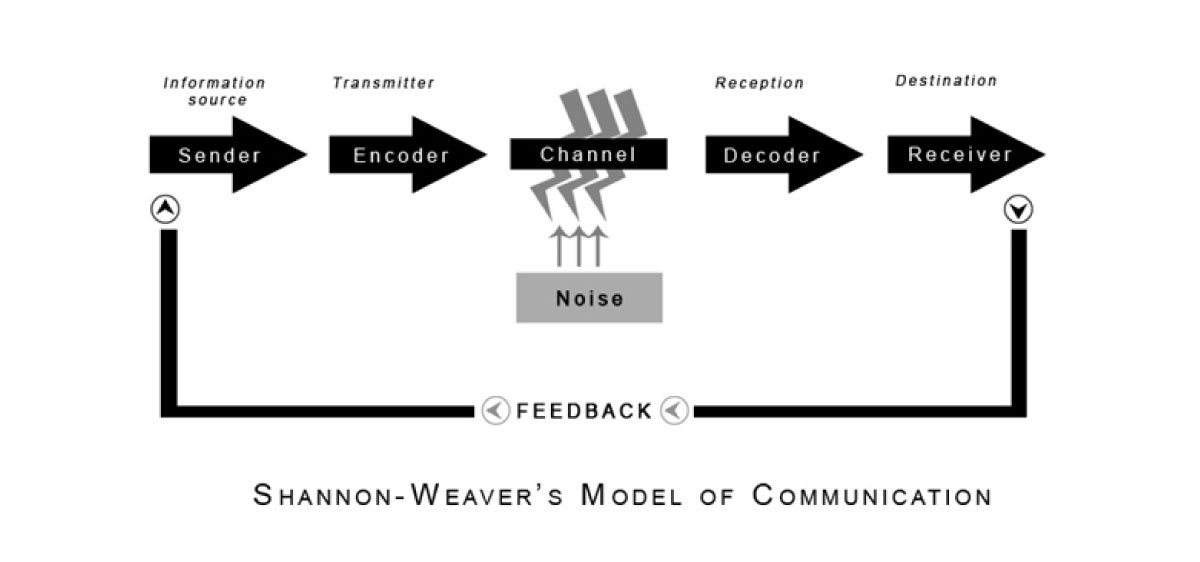
1. Sender (Information Source)
The sender refers to the “information source” (person or entity, like a brand) – starting with an intention (to inform, educate, to influence, to seduce, to persuade or to convince) to communicate something (a message, an idea, an opinion, a fact, a call to action, …) to someone.
2. Encoding (Transmitter)
The encoding is the process to convert the intention or idea into a spoken, written or non-verbal message. This could be shaped into words, images, sounds to allocate meaning to and trigger emotion through the communication.
3. Channel
The channel of communication refers to the means or media used to transmit the information or message to the receiver. Some examples of channels are: face-to-face conversation, phone call, email, short message – for personal communication, and also TV commercial, print ad – for brand or marketing communication.
4. Noise
Noise interferes with the transmission of a message, be it at the sender’s side or the receiver’s end (both internal noise), or somewhere in between (external). Noise can occur during encoding (spelling error), and can impact negatively or even prevent the decoding of the message by the receiver.
At the sender’s or receiver’s side, noise can be generated by the mood of either, or cognitive bias. This highlights the importance to be clear about the intent at the sender’s end, and to understand the needs, interests and motivations of the receiver or audience, in order to reduce the risk of noise.
Noise in between sender and receiver can be either technical (language errors when encoding the message, bad transmission signal, background noise), or can relate to competing or even conflicting messages. If your email lands in the middle of a pile of tens of emails received, this can impact the receiver’s capacity to decode and hence respond.
5. Decoding
Decoding is the “other side” of encoding. If encoding is about expressing the intention or idea in a message, decoding is about extracting the meaning of said message. Be able to receive, get attention, allocate meaning (interpret). As mentioned above, a bad mood, or a cognitive and cultural biases can and will influence the interpretation by the receiver.
6. Receiver (Destination)
The receiver is the end-point of the communication process. In other words, the audience at which the message is directed and/or intended.
7. Feedback
The final step of the model is feedback or response from the receiver back to the sender, closing as such the communication loop. This will express the interpretation by the receiver and indicate full, partial, or absence of, understanding. When the feedback by the receiver is in line with the original intention from the sender, we speak of effective communication.
| SENDER |
You |
Heineken |
| ENCODING |
Inform that you will be late for dinner |
Wants to grow awareness of it 0.0% beer sub-brand |
| CHANNEL |
Over the phone |
By airing a TV commercial during the football final half-time break |
| NOISE |
Calling from a bar during the football final |
However, the majority are either going to the bathroom, engaging in conversation, singing their team’s club song, ordering a new round of beers, calling their partner to say they will be late for dinner, |
| DECODING |
Hence your message can hardly be heard let alone understood |
Hence none of the adverts being aired on the TV are being noticed |
| RECEIVER |
By your partner |
By any of the football fans |
| FEEDBACK |
Who yells in the phone asking to send a text instead |
Who still have no idea that Heineken has a new 0.0% beer, hence won’t be buying any anytime soon.. |
Examples of the model of communication, for personal and for marketing communication
Shannon & Weaver’s model of communication, highlighting the stakes of encoding and decoding between sender and receiver, relates perfectly to the work of Paul Watzlawick who defined communication as an “interaction, an exchange or transmission of a message, received and interpreted by the audience. What matters therefore is not only the content of a message but also the way it is encoded and transmitted, as this will impact the way it is received and decoded.
Considered as one of the world’s leading communication experts, Watzlawick theorizes on the nature of human communication, based on the premise that “To understand himself, a man needs to be understood by someone else. In order for someone else to understand him, he needs to understand that person”. This statement underlines the importance of the relationship between sender and receiver, or rather the affinity and understanding, either mutually or at least from the sender’s point of view.
Coming back to our main topic – how to tackle a communication plan, it makes sense to focus on the audience you are aiming to reach. This might sound like working backwards, but it actually is about “starting with the end in mind”. In a true journalistic approach, you should start with answering the “WHO” before tackling the “WHAT”, “WHERE”, “WHEN” and “HOW”. Ready ? Let’s go !
WHO – RECEIVER
Know who you’re speaking to, or – to use the term from the Shannon-Weaver model – know your receiver. From a marketing point-of-view, this refers to the target customer profile, both in terms of demographics (factual aspects like age, gender, location, marital status, …) and psychographics (soft aspects like lifestyle, interests, needs, habits, …. in general, or in relation to a specific product or service category).
Just like for any communication, and as explained in the model of communication, understanding your audience starts with knowing what their Information needs are, based on their current level of knowledge or familiarity with the topic – in our case : the category, the brand and/or the product).
For example, introducing the latest MacBook Pro features to IT “geeks” who have been discussing the upcoming launch of your product on internet forums for months will not be the same as presenting exactly the same product to computer illiterates – even if the sender’s – or seller’s – intent will be the same : to convince the audience to buy the product. The former will be interested to know all technical details, whereas the latter will be keen to hear what the same technical features will actually do for them in their daily use.
True consumer insights are what we call the “sweet spot”, as these often reveal new or newly expressed insights in the consumer behaviour, such “aha” insights uncovered by your own research can give a competitive edge for your brand, your product, and not in the least your communication since you know perfectly what to say, and how to say it.
Taking it one step further, beyond their needs and interests, you should take into account the willingness to receive the message and openness to consider the content. To some extent we could label this in one word as the “mood” of the audience. Just think of a customer who had a bad user experience with your brand or product, they will be less considerate and more critical in decoding your message.
On another level, if your advertising message is similar to dozens of similar messages received in a given period of time, the audience will be less inclined or open to pay attention to yours, spam being the extreme of such an example.
WHAT – INTENT = FUNNEL, CONTENT & MESSAGE
The “WHAT” starts with the intent of your communication. There is no point in producing content or recording a message without knowing what you are trying to achieve with your communication: to inform or educate, to influence, to seduce, to persuade or to convince ?
In marketing terms, the intent can be brought back to one of the stages of the AIDA model, developed by American businessman and advertising expert Elias St. Elmo Lewis in 1898. Yes, that’s right, more than a century ago, but still valid today and of great value for marketing communication, as the model describes a series of stages that customers go through when making purchasing decisions, and as such establish targets – or intent – for communication at each stage:
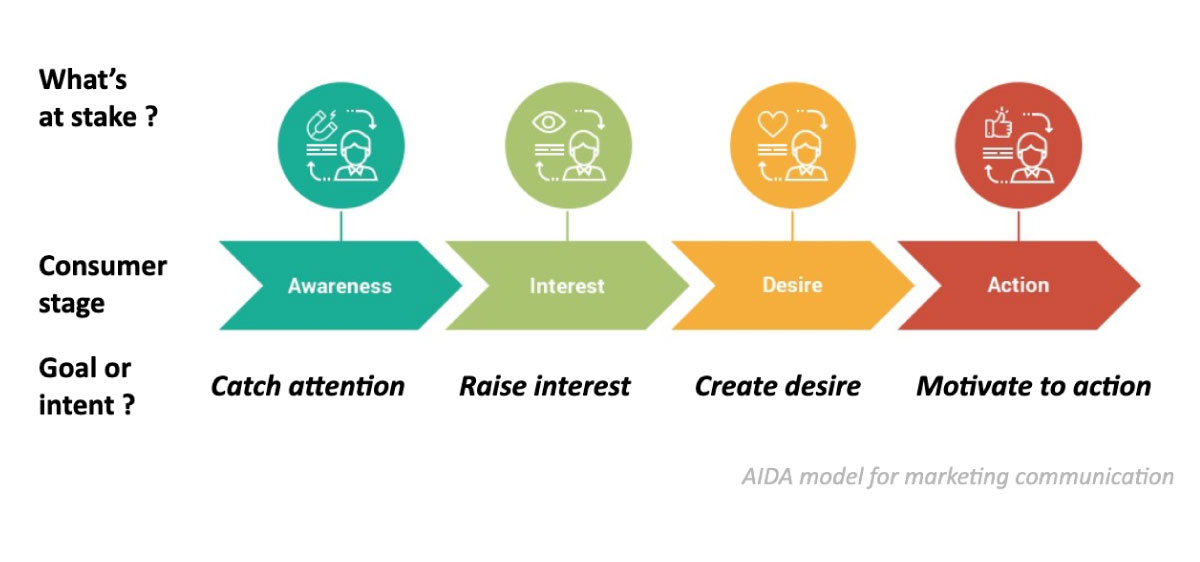
AIDA model for marketing communication
This model, originated in the 19th century, has been the inspiration for the development of marketing funnel models throughout the 20th century, with Awareness being the foundation (people need to know your brand exists) on which one can build interest (rational understanding of hat the product can do for you) and desire (emotional connection to the brand or the product), ultimately leading to purchase.
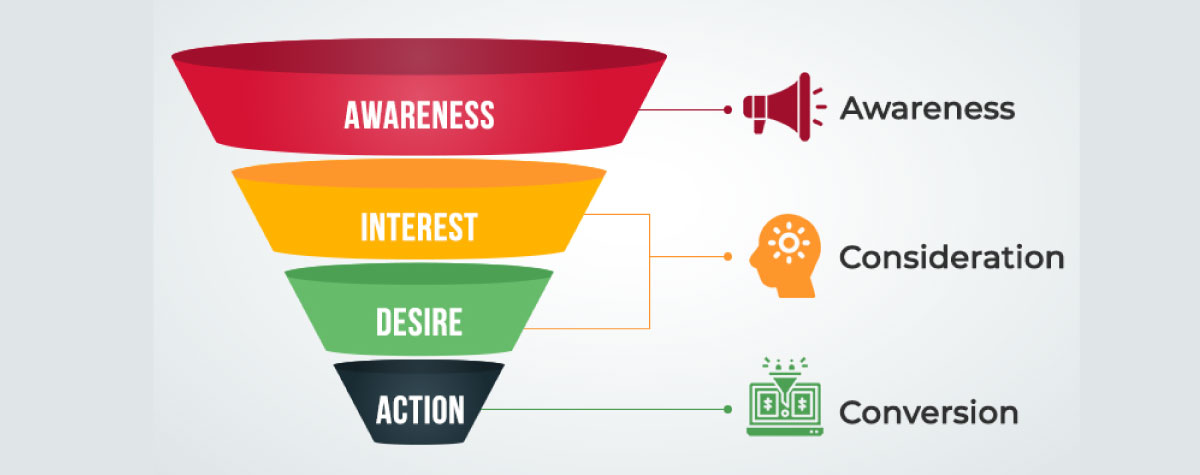
AIDA sales funnel and the buyer’s journey to purchase
In the AIDA model, the interest and desire relate to the level of intensity with which the consumer takes your brand or product into consideration, and as such gives an indication of the likelihood of moving into action, or – in other words – converting into a purchase.
Nowadays, numerous variations of these marketing funnels exist, ranging from a more sales conversion focus, to a purely digital angle. For the purpose of this paper we will use a rather extended version of the funnel, whose steps best reflect a full customer journey, beyond the first purchase, and including loyalty (repeat purchase) and advocacy (word-of-mouth), which can be relevant communication targets for your brand or product.
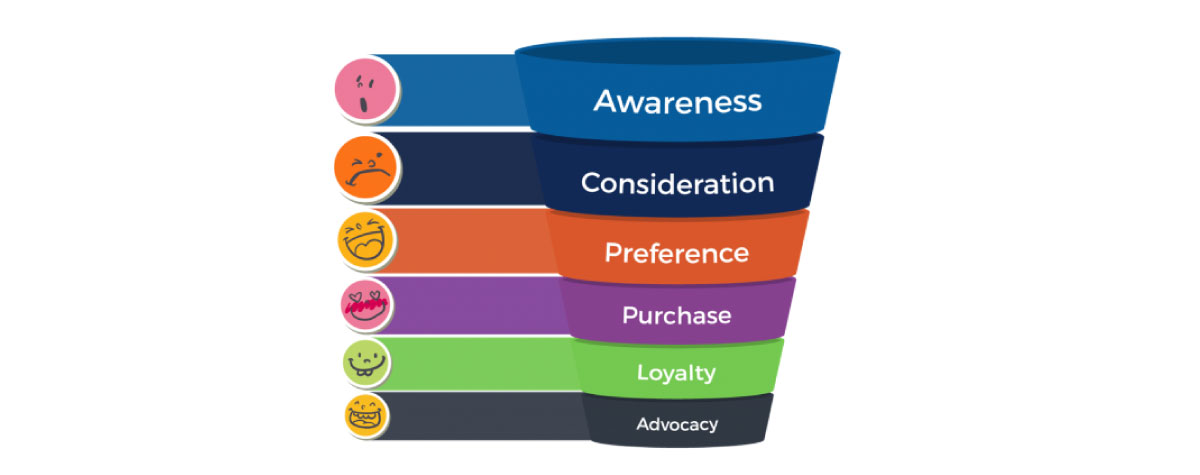
| MARKETING FUNNEL | COMMUNICATION INTENT | CUSTOMER SAYS / THINKS |
| AWARENESS | Recognition | “I have heard about this brand” |
| FAMILIARITY | Understanding & interest | I know what this brand has to offer |
| IMAGE | Knowledge & desire | I like what it stands for, how it’s different from other brands |
| PURCHASE | Conversion to sales | I want to buy the product |
| LOYALTY | Build 2-way dialogue | I love the brand experience |
| ADVOCACY | Life-time connection | I am a brand ambassador |
Only once the intent is clearly set against the marketing funnel and towards the identified target audience, the content of the message can start to take shape. The content has to deliver the communication intent and speak to the target audience. For example, visual for emotional impact to create desire, or testimonials to generate a more rational interest.
WHERE & WHEN – THE COMMUNICATION CHANNEL
Thanks to digitalization there are a multitude of channels to select from, yet this wealth of media also means that the choice is vast and dispersed – or in one word: cluttered. Bear in mind that such diversity not only applies to the sender, but also to the receiver who has access to the same multiplicity of choice, putting the audience in control: it is the consumer who decides which channel to use, and as such decide when and where to receive communication.
With the Shannon-Weaver model of communication in mind, and considering the claim from Paul Watzlawick, the audience – or the consumer in the case of marketing communication – is more and more in control. It therefore becomes crucial to choose the right communication channels or media. The plural refers to the opportunity offered by today’s diverse media landscape, allowing to use of multiple channels at different stages of the funnel, or at different times in order for the message to reach the audience in the most effective way, wherever and whenever is most suitable and effective.
HOW – TONE, BUT MOST OF ALL INTEGRATED & CONSISTENT
Whereas in standard communication between two or more individuals, the “HOW” could be limited to the tone of the message, in marketing communication the “HOW” is a much more complex question to tackle.
Robyn Blakeman states in “Integrated Marketing Communication” that “Selling a product or a service today requires the creative & strategic use of multiple media options.” Indeed, against the wide or almost unlimited choice of channels available, one has to ensure that the target audience received a consistent message in a consistent way.
This consistency refers not only to the look and feel between different media, but also the consistency with the brand’s philosophy and strategy. So, in order to be consistent towards the audience, the communication plan needs to be fully consistent with, or rather integrated within – in the brand strategy. Only then can a brand properly anticipate and consistently manage the various interaction channels and touchpoints with the target audience.
Whereas the brand strategy will define the strong vision, S.M.A.R.T. goals and priority strategies for the brand or company, the marketing strategy will consistently “translate” these into an inspiring brand positioning, a clear idea of the target audience and a claimable and unique selling proposition or USP.
The marketing communication plan then becomes the execution of these strategies through audience-targeted and consistent actions. Such integration and consistency will even strengthen the effectiveness of the communication, with synergies emerging between various channels and streamlining the conversion throughout the marketing funnel, fuelling the brand equity over time.
The above explanation describes what Integrated Marketing Communication or Strategic Communication means. In the same spirit, Hallahan et al. define strategic communication as “the purposeful use of communication by an organization to fulfil its mission”, highlighting the need for genuine integration with the brand strategy.
On a more “hands-on” level, Shayna Englin, Professor, public relations & corporate communications at Georgetown, stated that “being strategic means communicating the best message, through the right channels, to specific audiences, measured against well-considered organizational and communications-specific goals”, or as she concluded : It’s the difference between doing communications stuff, and doing the right communications stuff.”
CONCLUSION
Just like the marketing funnel starts with awareness, your approach to a communication plan should be based on Paul Watzlawick’s axiom stating that our communication is both conscious and unconscious – or planned and unplanned.
From there, Shannon-Weaver’s model of communication hands a structured approach evolving around your target: both the audience and your intention. Having a genuine understanding of these will allow to fill in the blanks or missing links: encode your intention into a message and choosing the appropriate channel
Being clear about our goals or intention, truly understanding the audience we are communicating to and with, will also ensure that any marketing communication is rooted in the brand’s mission and values, integrated in the brand strategy, and will be delivered consistently across the various channels used, throughout the different stages of the marketing funnel, and over time.
So, in order to define and deploy a truly consistent and integrated communication plan today, you can still rely on theories developed around a century ago.
